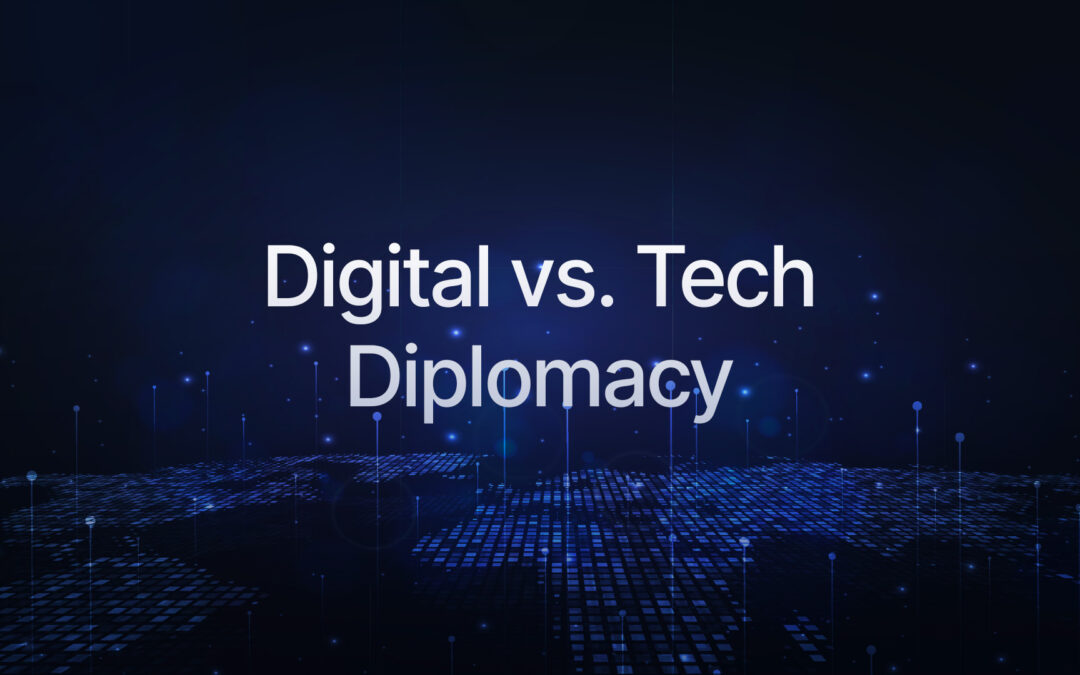In an era where tweets can trigger international incidents and artificial intelligence reshapes global power dynamics, two terms have become increasingly prominent in diplomatic circles: digital diplomacy and tech diplomacy. While often used interchangeably, these concepts represent distinct approaches to international relations in the digital age. This article aims to demystify these terms, exploring their differences and implications for the future of global governance.
The Rise of Digital Diplomacy
Digital diplomacy, at its core, involves the use of digital tools and platforms to achieve diplomatic objectives. Ilan Manor, a digital diplomacy researcher at the University of Oxford, defines it as “the use of social media platforms by foreign ministries to communicate with foreign publics and gather information that may be of use to policy makers” (Manor, 2019).
This approach has revolutionized how nations manage their international image and respond to crises. A prime example is the U.S. State Department’s use of social media during the Arab Spring. As Jared Cohen, a former advisor to Secretaries of State Condoleezza Rice and Hillary Clinton, noted, “Social media has become a primary tool of how the U.S. government communicates with people around the world” (Bradshaw, 2015).
However, digital diplomacy is not without its challenges. The instantaneous nature of social media can lead to diplomatic faux pas with real-world consequences. A notable example occurred in 2014 when the British Embassy in Washington faced backlash for a tweet about the 200th anniversary of the burning of the White House. The tweet, which showed a White House cake surrounded by sparklers, read: “Commemorating the 200th anniversary of burning the White House. Only sparklers this time!” This attempt at humor was met with criticism from many Twitter users who found it in poor taste, prompting the embassy to issue an apology within hours (BBC News, 2014). This incident highlights the potential pitfalls of digital engagement in diplomacy, where a misguided attempt at lighthearted communication can quickly escalate into an international incident.

Tech Diplomacy: Beyond Digital Tools
While digital diplomacy focuses on using technology for diplomatic purposes, tech diplomacy addresses the diplomatic implications of technology itself. Denmark’s appointment of Casper Klynge as the world’s first “tech ambassador” in 2017 marked a significant milestone in this field.
Klynge described his role as “focusing on the intersection between technology, democracy, and foreign and security policy” (Klynge et al., 2020). This approach recognizes that tech companies often wield influence comparable to nation-states in shaping global affairs.
Tech diplomacy encompasses a range of activities, from negotiating international tech standards to addressing the geopolitical implications of emerging technologies. As Amandeep Singh Gill, former Executive Director of the UN Secretary General’s High-Level Panel on Digital Cooperation, points out, “Diplomacy has to evolve to address the challenges and opportunities of digital technologies” (Gill, 2020).
Comparative Analysis
While both digital and tech diplomacy operate in the realm of technology and international relations, they differ in several key aspects:
- Focus: Digital diplomacy emphasizes the use of digital tools for traditional diplomatic functions, while tech diplomacy addresses the broader implications of technological development on geopolitics.
- Stakeholders: Digital diplomacy primarily engages with foreign publics and traditional diplomatic counterparts. Tech diplomacy often involves direct engagement with tech companies, innovators, and scientific communities.
- Skill Set: Digital diplomacy requires proficiency in digital communication and online engagement. Tech diplomacy demands a deeper understanding of technological trends and their geopolitical implications.
- Objectives: Digital diplomacy aims to enhance traditional diplomatic functions through digital means. Tech diplomacy seeks to shape the global technological landscape and harness it for national interests.
Future Implications
As technology continues to reshape global affairs, both digital and tech diplomacy will play crucial roles. The COVID-19 pandemic has accelerated the adoption of digital diplomacy tools, with virtual summits and online negotiations becoming the norm. Simultaneously, issues like data governance, AI ethics, and cybersecurity are pushing tech diplomacy to the forefront of international relations.
Corneliu Bjola, Professor of Diplomatic Studies at the University of Oxford, argues that “the future of diplomacy will be determined by how well diplomats can adapt to and shape the digital environment” (Bjola, 2019). This adaptation will likely require a blend of both digital and tech diplomatic skills.
Conclusion
Understanding the nuances between digital diplomacy and tech diplomacy is crucial for policymakers, diplomats, and citizens alike. As nations navigate the complexities of a tech-driven world, mastering both these forms of diplomacy will be essential for effective international relations.
The diplomats of tomorrow will need to be as comfortable discussing neural networks as they are negotiating treaties. In this new landscape, the lines between foreign policy, technology, and diplomacy are increasingly blurred. Nations that can effectively leverage both digital and tech diplomacy may well be the ones that lead in the decades to come.
References
BBC News. (2014, August 25). British Embassy apologises for White House tweet. BBC News. https://www.bbc.com/news/world-us-canada-28929626
Bjola, C. (2019). Digital diplomacy 2.0? A cross-national comparison of public engagement in Facebook and Twitter. The Hague Journal of Diplomacy, 14(1-2), 83-101. https://doi.org/10.1163/1871191X-14011032
Bradshaw, S. (2015). Digital diplomacy—#notdiplomacy. In C. Bjola & M. Holmes (Eds.), Digital diplomacy: Theory and practice (pp. 23-39). Routledge.
Gill, A. S. (2020). The changing nature of diplomacy in the digital age. Global Policy, 11(3), 362-370. https://doi.org/10.1111/1758-5899.12815
Klynge, C., Ekman, M., & Waedegaard, N. J. (2020). Diplomacy in the digital age: Lessons from Denmark’s TechPlomacy initiative. The Hague Journal of Diplomacy, 15(1-2), 185-195. https://doi.org/10.1163/1871191X-15101094
Manor, I. (2019). The digitalization of public diplomacy. Palgrave Macmillan. https://doi.org/10.1007/978-3-030-04405-3

